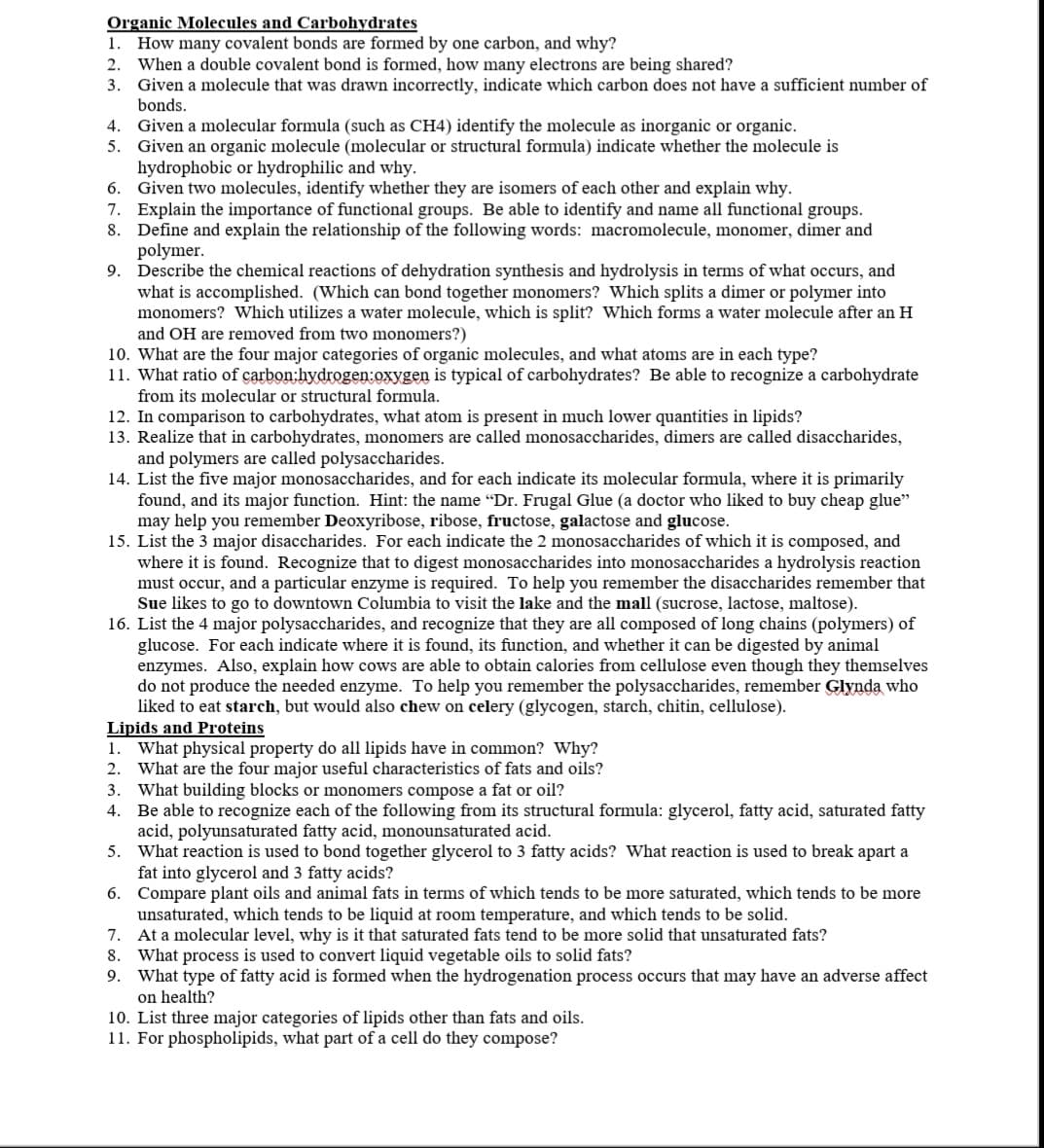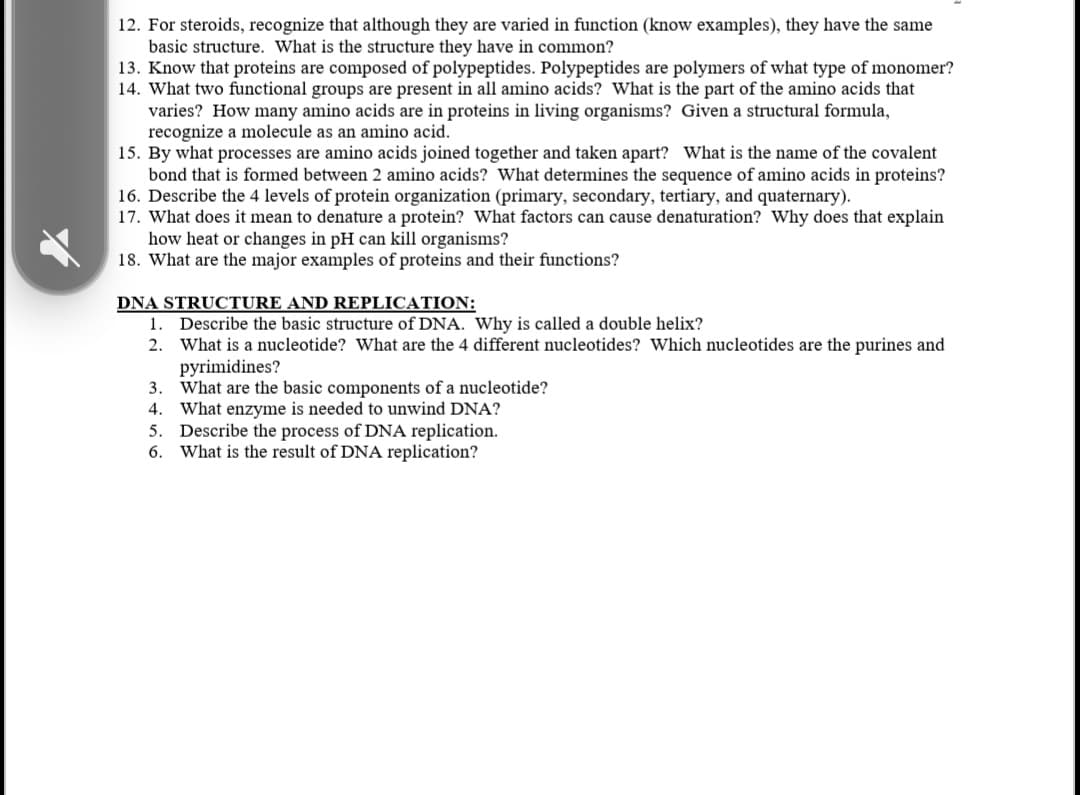ponds. Given a molecular formula (such as CH4) identify the molecule Given an organic molecule (molecular or structural formula) ind aydrophobic or hydrophilic and why. Given two molecules, identify whether they are isomers of each Explain the importance of functional groups. Be able to identify Define and explain the relationship of the following words: mac polymer. Describe the chemical reactions of dehydration synthesis and hy what is accomplished. (Which can bond together monomers? V nonomers? Which utilizes a water molecule, which is split? w and OH are removed from two monomers?) What are the four major categories of organic molecules, and wl What ratio of carbon:hydrogen:oxygen is typical of carbohydrat rom its molecular or structural formula. in comparison to carbohydrates, what atom is present in much lo Realize that in carbohydrates, monomers are called monosaccha and polymers are called polysaccharides. List the five major monosaccharides, and for each indicate its m ound, and its major function. Hint: the name "Dr. Frugal Glue nay help you remember Deoxyribose, ribose, fructose, galactos List the 3 major disaccharides. For each indicate the 2 monosac where it is found. Recognize that to digest monosaccharides inte nust occur, and a particular enzyme is required. To help you re Sue likes to go to downtown Columbia to visit the lake and the i List the 4 major polysaccharides, and recognize that they are all glucose. For each indicate where it is found, its function, and w. enzymes. Also, explain how cows are able to obtain calories frc do not produce the needed enzyme. To help you remember the p iked to eat starch, but would also chew on celery (glycogen, sta ds and Proteins
ponds. Given a molecular formula (such as CH4) identify the molecule Given an organic molecule (molecular or structural formula) ind aydrophobic or hydrophilic and why. Given two molecules, identify whether they are isomers of each Explain the importance of functional groups. Be able to identify Define and explain the relationship of the following words: mac polymer. Describe the chemical reactions of dehydration synthesis and hy what is accomplished. (Which can bond together monomers? V nonomers? Which utilizes a water molecule, which is split? w and OH are removed from two monomers?) What are the four major categories of organic molecules, and wl What ratio of carbon:hydrogen:oxygen is typical of carbohydrat rom its molecular or structural formula. in comparison to carbohydrates, what atom is present in much lo Realize that in carbohydrates, monomers are called monosaccha and polymers are called polysaccharides. List the five major monosaccharides, and for each indicate its m ound, and its major function. Hint: the name "Dr. Frugal Glue nay help you remember Deoxyribose, ribose, fructose, galactos List the 3 major disaccharides. For each indicate the 2 monosac where it is found. Recognize that to digest monosaccharides inte nust occur, and a particular enzyme is required. To help you re Sue likes to go to downtown Columbia to visit the lake and the i List the 4 major polysaccharides, and recognize that they are all glucose. For each indicate where it is found, its function, and w. enzymes. Also, explain how cows are able to obtain calories frc do not produce the needed enzyme. To help you remember the p iked to eat starch, but would also chew on celery (glycogen, sta ds and Proteins
Biology 2e
2nd Edition
ISBN:9781947172517
Author:Matthew Douglas, Jung Choi, Mary Ann Clark
Publisher:Matthew Douglas, Jung Choi, Mary Ann Clark
Chapter2: The Chemical Foundation Of Life
Section: Chapter Questions
Problem 3VCQ: Figure 2.24 Which of the following statements is false? Molecules with the formulas CH3CH2COOH and...
Related questions
Question

Transcribed Image Text:Organic Molecules and Carbohydrates
How many covalent bonds are formed by one carbon, and why?
When a double covalent bond is formed, how many electrons are being shared?
3. Given a molecule that was drawn incorrectly, indicate which carbon does not have a sufficient number of
bonds.
1.
2.
Given a molecular formula (such as CH4) identify the molecule as inorganic or organic.
5. Given an organic molecule (molecular or structural formula) indicate whether the molecule is
hydrophobic or hydrophilic and why.
6. Given two molecules, identify whether they are isomers of each other and explain why.
7. Explain the importance of functional groups. Be able to identify and name all functional groups.
Define and explain the relationship of the following words: macromolecule, monomer, dimer and
polymer.
9. Describe the chemical reactions of dehydration synthesis and hydrolysis in terms of what occurs, and
what is accomplished. (Which can bond together monomers? Which splits a dimer or polymer into
monomers? Which utilizes a water molecule, which is split? Which forms a water molecule after an H
and OH are removed from two monomers?)
4.
8.
10. What are the four major categories of organic molecules, and what atoms are in each type?
11. What ratio of carbon;hydrogen:oxygen is typical of carbohydrates? Be able to recognize a carbohydrate
from its molecular or structural formula.
12. In comparison to carbohydrates, what atom is present in much lower quantities in lipids?
13. Realize that in carbohydrates, monomers are called monosaccharides, dimers are called disaccharides,
and polymers are called polysaccharides.
14. List the five major monosaccharides, and for each indicate its molecular formula, where it is primarily
found, and its major function. Hint: the name "Dr. Frugal Glue (a doctor who liked to buy cheap glue"
may help you remember Deoxyribose, ribose, fructose, galactose and glucose.
15. List the 3 major disaccharides. For each indicate the 2 monosaccharides of which it is composed, and
where it is found. Recognize that to digest monosaccharides into monosaccharides a hydrolysis reaction
must occur, and a particular enzyme is required. To help you remember the disaccharides remember that
Sue likes to go to downtown Columbia to visit the lake and the mall (sucrose, lactose, maltose).
16. List the 4 major polysaccharides, and recognize that they are all composed of long chains (polymers) of
glucose. For each indicate where it is found, its function, and whether it can be digested by animal
enzymes. Also, explain how cows are able to obtain calories from cellulose even though they themselves
do not produce the needed enzyme. To help you remember the polysaccharides, remember Glynda who
liked to eat starch, but would also chew on celery (glycogen, starch, chitin, cellulose).
Lipids and Proteins
1. What physical property do all lipids have in common? Why?
What are the four major useful characteristics of fats and oils?
3. What building blocks or monomers compose a fat or oil?
4. Be able to recognize each of the following from its structural formula: glycerol, fatty acid, saturated fatty
acid, polyunsaturated fatty acid, monounsaturated acid.
5. What reaction is
fat into glycerol and 3 fatty acids?
6. Compare plant oils and animal fats in terms of which tends to be more saturated, which tends to be more
unsaturated, which tends to be liquid at room temperature, and which tends to be solid.
7. At a molecular level, why is it that saturated fats tend to be more solid that unsaturated fats?
8. What process is used to convert liquid vegetable oils to solid fats?
What type of fatty acid is formed when the hydrogenation process occurs that may have an adverse affect
on health?
2.
to bond together glycerol to 3 fatty acids?
break apart a
9.
10. List three major categories of lipids other than fats and oils.
11. For phospholipids, what part of a cell do they compose?

Transcribed Image Text:12. For steroids, recognize that although they are varied in function (know examples), they have the same
basic structure. What is the structure they have in common?
13. Know that proteins are composed of polypeptides. Polypeptides are polymers of what type of monomer?
14. What two functional groups are present in all amino acids? What is the part of the amino acids that
varies? How many amino acids are in proteins in living organisms? Given a structural formula,
recognize a molecule as an amino acid.
15. By what processes are amino acids joined together and taken apart? What is the name of the covalent
bond that is formed between 2 amino acids? What determines the sequence of amino acids in proteins?
16. Describe the 4 levels of protein organization (primary, secondary, tertiary, and quaternary).
17. What does it mean to denature a protein? What factors can cause denaturation? Why does that explain
how heat or changes in pH can kill organisms?
18. What are the major examples of proteins and their functions?
DNA STRUCTURE AND REPLICATION:
1. Describe the basic structure of DNA. Why is called a double helix?
2. What is a nucleotide? What are the 4 different nucleotides? Which nucleotides are the purines and
pyrimidines?
3. What are the basic components of a nucleotide?
4. What enzyme is needed to unwind DNA?
5. Describe the process of DNA replication.
6.
What is the result of DNA replication?
Expert Solution
This question has been solved!
Explore an expertly crafted, step-by-step solution for a thorough understanding of key concepts.
This is a popular solution!
Trending now
This is a popular solution!
Step by step
Solved in 2 steps

Recommended textbooks for you

Biology 2e
Biology
ISBN:
9781947172517
Author:
Matthew Douglas, Jung Choi, Mary Ann Clark
Publisher:
OpenStax

Biology (MindTap Course List)
Biology
ISBN:
9781337392938
Author:
Eldra Solomon, Charles Martin, Diana W. Martin, Linda R. Berg
Publisher:
Cengage Learning

Biology: The Dynamic Science (MindTap Course List)
Biology
ISBN:
9781305389892
Author:
Peter J. Russell, Paul E. Hertz, Beverly McMillan
Publisher:
Cengage Learning

Biology 2e
Biology
ISBN:
9781947172517
Author:
Matthew Douglas, Jung Choi, Mary Ann Clark
Publisher:
OpenStax

Biology (MindTap Course List)
Biology
ISBN:
9781337392938
Author:
Eldra Solomon, Charles Martin, Diana W. Martin, Linda R. Berg
Publisher:
Cengage Learning

Biology: The Dynamic Science (MindTap Course List)
Biology
ISBN:
9781305389892
Author:
Peter J. Russell, Paul E. Hertz, Beverly McMillan
Publisher:
Cengage Learning

Human Biology (MindTap Course List)
Biology
ISBN:
9781305112100
Author:
Cecie Starr, Beverly McMillan
Publisher:
Cengage Learning